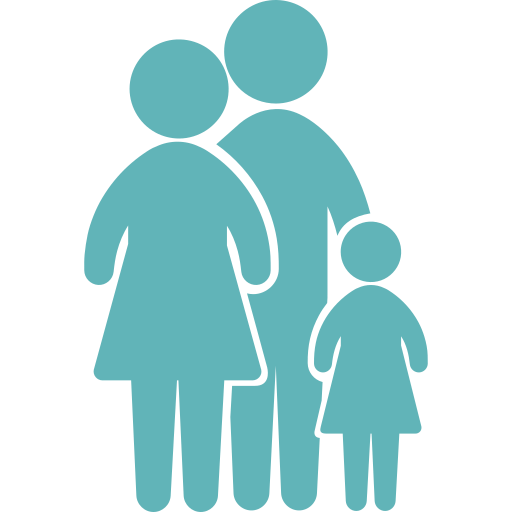Adoption and Permanency
A Guide to Adoption, Permanent Legal Custody, and Foster-to-Adopt
Types of Permanency
The goal for all foster children is to return to a permanent, safe living situation. There are three primary permanency goals: reunification, adoption, and permanent legal custody (PLC).
Reunification
The first goal of foster care is always reunification of children to their birth families. When a child is placed in foster care, the court sets forth goals for the birth family to achieve before reunification can be considered. If the birth parents are able to meet these goals, then the family can be restored.
Adoption
If a child cannot be returned home safely and in a timely manner, the next most permanent plan is for adoption by a qualified and loving family. The adoption process involves the termination of the birth parents’ rights and the creation of parental rights to new adoptive parents. Adoptive families may or may not be related to the child or youth before the adoption. Most children in placement are adopted by their current kinship or foster parent.
Permanent Legal Custody
PLC is intended to be a permanent arrangement, but, unlike adoption, does not involve termination of the parents’ rights. PLC is only considered when both reunification and adoption are not possible. Under PLC, birth parents may retain certain rights, such as visitation, that they would not have under adoption. Most often, the current kinship or foster parent becomes the permanent legal guardian.
Permanency Through Adoption
When a parent’s rights are terminated, the next permanency goal is adoption. Adoptive parents may or may not be previously related to the child.
1. Family Relatives
The first choice of adoptive home is placement with another relative or family member. In PA, relatives to the fifth degree are eligible for adoption. For more information, see the Child Welfare State Statutes.
2. Resource Family
When no relatives are willing or able to adopt a child, the next best option is adoption by the current foster family.
3. Preadoptive Family
If adoption is not possible by other relatives or by the foster family, a child may be adopted by another unrelated family called a preadoptive family.
Parenting Options
Parents can care for children in need of a home through multiple paths.
Foster Care
Timeframe: temporary
Cost: minimal
Foster care involves caring for a child who cannot live with their birth family for a variety of reasons. The goal of foster care is family reunification. Foster parents (resource parents) care for a child while a CUA caseworker works towards future permanency goals, such as reunification, adoption, or permanent legal custody. If the parental rights of the birth parents are terminated, the foster family may assist in helping find an adoptive family for their child through the Statewide Adoption Network (SWAN) or similar programs.
Foster to Adopt
Timeframe: temporary and permanent
Cost: minimal
When children are unable to be reunited with their birth families, the CUA caseworker will begin searching for an adoptive family. During the foster care certification process, foster families have the option to be designated as a potential preadoptive family. While the main goal of foster care is always reunification with the birth family, if a child is unable to be reunited, the foster family may be asked if they would be willing to adopt their child.
It is important to note that other birth relatives generally have priority in adoption over the current foster family, and the caseworker and court will make an effort to find options for kinship adoption. However, if no family relatives are identified that would be able to adopt, the foster family is typically offered the chance to adopt before other preadoptive families.
Adoption from Foster Care
Timeframe: permanent
Cost: minimal
Sometimes, potential parents are not able to participate in foster care, but are still interested in adoption. As mentioned previously, when parental rights have been terminated, other family relatives have the first opportunity to adopt. Next, the current foster family is often given the choice to adopt.
If neither of those options is possible, the child is listed on a statewide adoption registry called the PA Adoption Exchange, which is managed by the Statewide Adoption Network (SWAN). A list of available children can be found on the SWAN photo album.
Preadoptive families require much of the same clearances and training that foster parents do. The SWAN website has a full description of the preadoptive family application and selection process. A list of available Philadelphia agencies can be found on the Certification Guide or using the PA State Services Search.
The cost of adoption through SWAN is significantly subsidized by the state and often requires minimal if any input from the preadoptive family.
Private Adoption
Timeframe: permanent
Cost: high
Aside from the state adoption registry, there are many other private adoption agencies looking to match potential preadoptive parents to children in need of a home. It is important to note that while adoption through SWAN is heavily subsidized by the state, private adoption typically costs anywhere from $25,000-$50,000.
Learn More About Foster Care
The following guides can help get you up to speed on several important aspects of foster care in Philadelphia.
Finances
Learn about financial support available for foster parents.
Healthcare
Learn about healthcare topics such as doctors visits and insurance.
The Legal System
Learn about family court, hearings, and child custody.
Caseworkers and Visits
Learn about the different types of caseworkers, home visits, and parent visits.
New Placements
Learn about what to ask when receiving a new placement and the first week in care
School and Daycare
Learn more about education, school, and daycare.
Adoption and Permanency
Learn about foster care, adoption, and foster-to-adopt.
Foster Care Policies
Learn about policies like travel and babysitters
